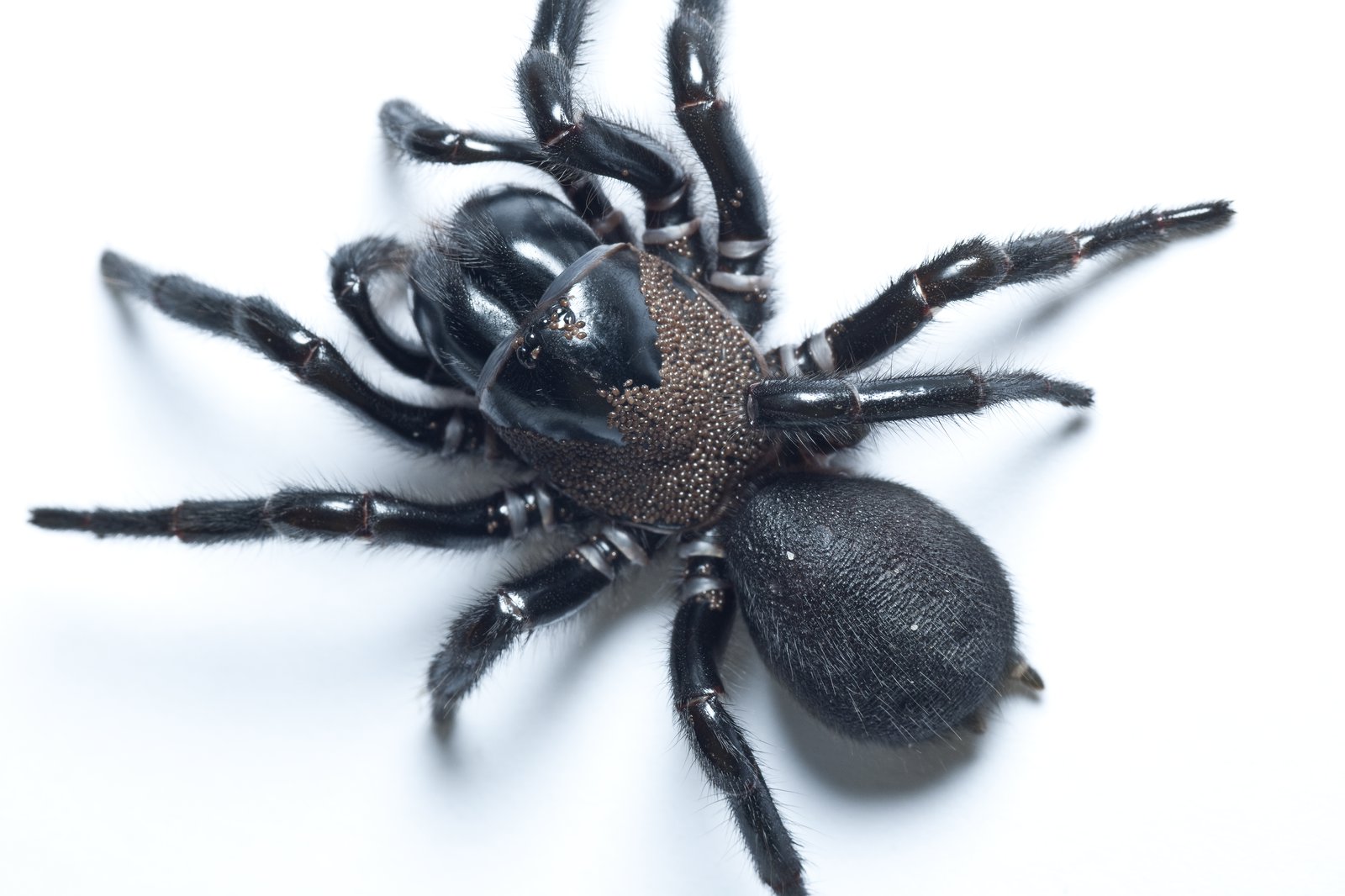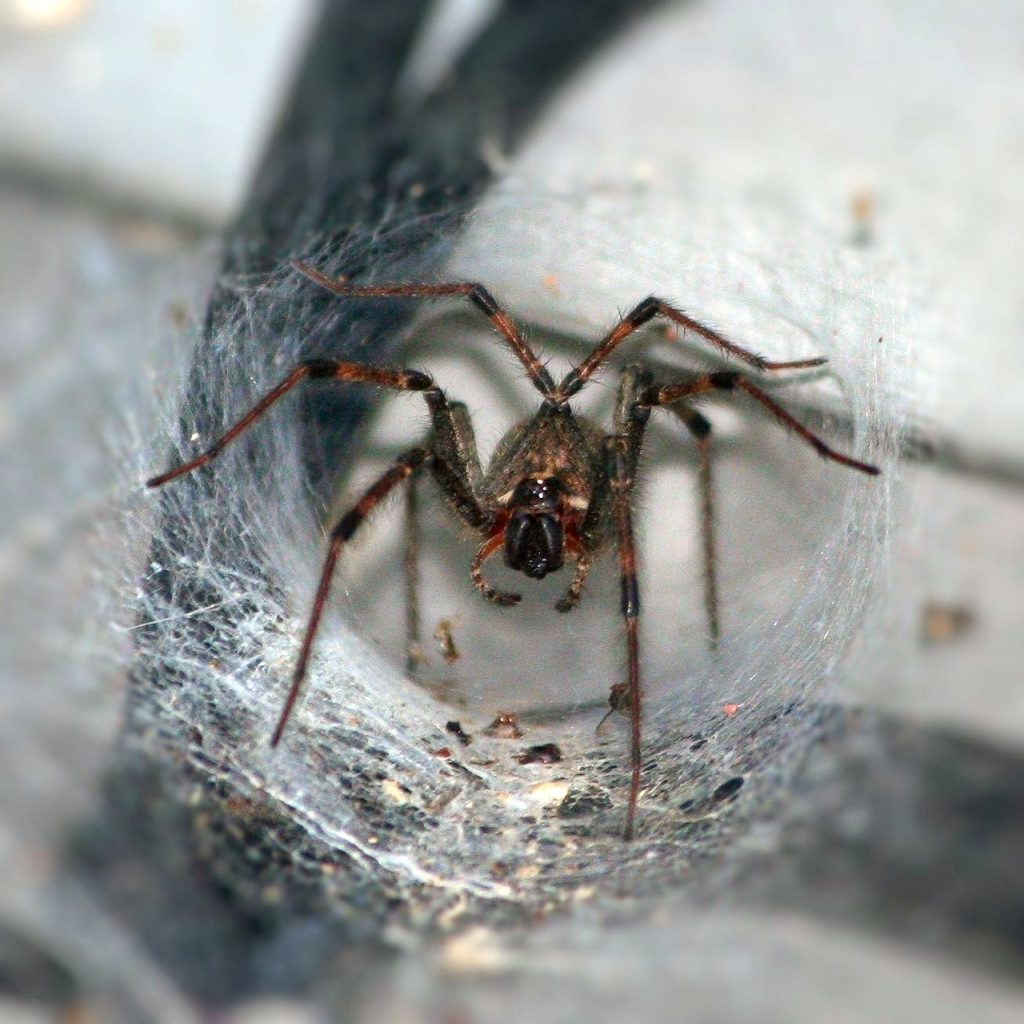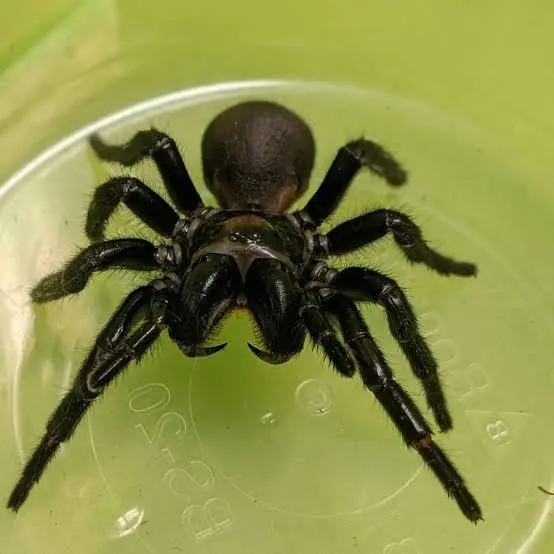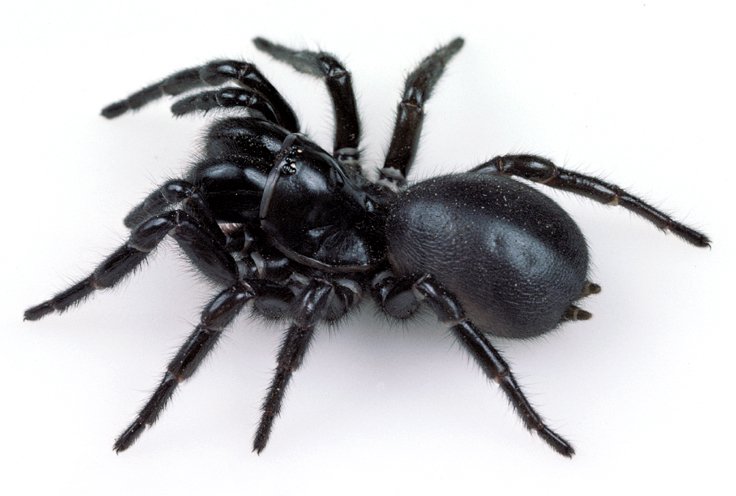
Atracidae is a family of mygalomorph spiders, commonly known as Australian funnel-web spiders or atracids. It has been included as a subfamily of the Hexathelidae, but is now recognised as a separate family. All members of the family are native to Australia. Atracidae consists of three genera: Atrax, Hadronyche, and Illawarra, comprising 35 species. Some members of the family produce venom that is dangerous to humans, and bites by spiders of six of the species have caused severe injuries to victims. The bites of the Sydney funnel-web spider (Atrax robustus) and northern tree-dwelling funnel-web spider (Hadronyche formidabilis) are potentially deadly, but no fatalities have occurred since the introduction of modern first-aid techniques and antivenom.
Understanding The Australian Funnel-web Spider

Photo by JamesDeMers on Pixabay
The Australian funnel-web spider, a member of the family Atracidae, is a creature that has been the subject of both fascination and fear. This article aims to provide a comprehensive overview of this remarkable arachnid, exploring its characteristics, habitats, life cycle, and the potential dangers it poses to humans.
Introduction to Australian Funnel-web Spiders
Australian funnel-web spiders, belonging to the family Atracidae, are native to Australia and are known for their distinctive web shape and potent venom. The family comprises three genera – Atrax, Hadronyche, and Illawarra – with a total of 35 species.
Six of these species have been linked to serious human injuries following spider bites. However, the Sydney funnel-web spider (Atrax robustus) and the northern tree-dwelling funnel-web spider (Hadronyche formidabilis) are regarded as the most dangerous. Despite their fearsome reputation, no fatalities have been recorded since the availability of modern first-aid techniques and antivenom.
Distinguishing Features of Australian Funnel-web Spiders
Australian funnel-web spiders are generally medium to large in size, with their body length ranging from 1 to 5 cm, inclusive of their legs. The colors of these spiders can vary from blue-black, black, to different shades of brown.
A prominent feature of these spiders is their eight small eyes, arranged in a thin rectangular cluster on the head’s front. Their subpar eyesight is compensated by their heightened sensitivity to vibrations, making them efficient ambush predators.
Understanding the Web Structure
The name ‘funnel-web spider’ derives from the unique web structure these spiders weave. The web comprises long silk threads that narrow into a funnel leading to the spider’s burrow, creating a small hole. The burrow is lined with silk, forming a tunnel that is usually less than 30 cm long.
Contrary to popular belief, the web of a funnel-web spider is not sticky. Instead, the silk strands serve to slow down and trip potential prey, allowing the spider to attack, bite, and inject its venom.
Habitats of Australian Funnel-web Spiders
Funnel-web spiders are quite adaptable and inhabit a variety of environments. These spiders are often found in burrows near the ground, under rocks, logs, or in tree stumps. Some species also inhabit tree trunks and ferns above the ground.
The majority of these spiders are sedentary, choosing to reside within their burrows for their entire lives unless they are persistently disturbed. Males of some species, like the Sydney funnel-web spider, are known to wander around at night, especially after rainfall.
Life Cycle and Reproduction
The reproduction process of Australian funnel-web spiders involves the male communicating with the female through a method known as ‘web stroking’. If the female shows interest, she allows the male into her web.
Following successful mating, the female lays between 100 to 200 eggs in an egg case. After approximately a month, the eggs hatch, releasing spiderlings that already resemble adult spiders, albeit in a smaller form.
The young spiders grow by shedding their skin, eventually constructing their own webs where they will live for the rest of their lives. The lifespan of these spiders can vary, with many living for about a year. However, spiders residing in warmer climates may have a longer lifespan.
Safety Measures and Human Interaction
Despite their venomous nature, Australian funnel-web spiders generally pose a low risk to humans as they prefer to keep to themselves. They will only bite when they feel threatened or disturbed.
In areas known to be inhabited by funnel-web spiders, it is advised to wear shoes with thick soles and use gloves for activities like gardening. Additionally, it is crucial to be cautious around potential spider burrows.
Dealing with Spider Bites
A bite from a funnel-web spider, especially the Sydney funnel-web spider, should be treated as a medical emergency. Symptoms can include rapid heart rate, difficulty swallowing, double vision, sweating, and confusion, among others.
If a bite occurs, the victim should clean the bite area with soap and water and wrap it in a bandage. It is also advised to immobilize the area with a splint and keep the body as still as possible while waiting for medical help. Since the development of an effective antivenom in 1980, no deaths have occurred from a funnel-web spider bite.
Conclusion
While the Australian funnel-web spider has a frightening reputation, understanding more about this unique creature can help reduce unnecessary fear. Despite being potentially dangerous, these spiders play a critical role in maintaining the balance of ecosystems. They serve as effective pest controllers by feeding on various insects. With the correct precautions and respect for these spiders, humans can safely coexist with these incredible creatures.
Remember, the best way to avoid a negative encounter with a funnel-web spider is to leave them undisturbed in their natural habitats. They are an integral part of Australia’s rich biodiversity and deserve our understanding and respect.

How to Identify a Funnel-Web Spider: Tips and Tricks
Funnel-web spiders are known for their highly venomous bites, which can be fatal to humans and other animals. These spiders are native to Australia and are commonly found in gardens, parks, and forests. Being able to identify a funnel-web spider is crucial for anyone living in or visiting Australia, as it can help prevent dangerous encounters.
One way to identify a funnel-web spider is by its appearance. Funnel-web spiders are usually medium to large in size and are different shades of black and brown. They have a stocky body and short legs, which are adapted for burrowing. The front part of their body, where their legs are attached, is glossy, which helps distinguish them from other dark-colored spiders like trapdoor and black house spiders, which are covered in fine hairs [1].
It’s important to note that not all funnel-web spiders are dangerous to humans. Only male funnel-web spiders of the Atrax and Hadronyche genera are known to have venom that can cause serious harm. However, it’s best to avoid handling any funnel-web spider and seek medical attention immediately if bitten. By learning how to identify a funnel-web spider, you can take the necessary precautions to stay safe in areas where these spiders are commonly found.
Identifying Characteristics
Funnel-web spiders are a group of spiders known for their funnel-shaped webs and venomous bites. Here are some identifying characteristics to help you recognize a funnel-web spider.
Size and Shape
Funnel-web spiders are medium to large-sized spiders, with an average body length of about 1-2 inches. They have a stocky and robust build, with a large cephalothorax (head and thorax) and a smaller abdomen. The legs are short and sturdy, with two claws at the end of each leg. The body shape is similar to that of a tarantula, but with a more streamlined appearance.
Color and Markings
Funnel-web spiders are typically dark-colored, ranging from black to brown. They have a glossy head and thorax, with small and closely-grouped eyes. Some funnel-web spiders may have a slight pattern on their body, but most are a singular color. The carapace, which is a hard, shell-like section that covers the back of many different animals, is easily recognizable near the front of the spider’s body.
Web Structure
Funnel-web spiders are named for their funnel-shaped webs, which they use to trap prey. The web is made of silk and is usually constructed in a sheltered location, such as in a crevice or under a rock. The funnel-shaped entrance is at the top of the web, and the spider waits at the bottom of the funnel for prey to become trapped in the web. The web is typically not visible from a distance, as it blends in with the surrounding environment.
Overall, these identifying characteristics can help you recognize a funnel-web spider. If you encounter one, it is important to exercise caution, as their venomous bite can be dangerous. If you suspect that you have been bitten by a funnel-web spider, seek medical attention immediately.

Habitat and Distribution
Funnel-web spiders are found in various parts of the world. They are most commonly found in Australia, where they are known for their venomous bites. According to Animal Corner, there are over 35 species of funnel-web spiders in Australia. These spiders are usually found in the eastern and southern parts of the country, including New South Wales, Victoria, and Queensland.
Geographical Range
Funnel-web spiders are also found in other parts of the world, including South America, Africa, and Asia. In South America, these spiders are commonly found in Brazil, Argentina, and Paraguay. In Africa, they are found in countries such as Zimbabwe and Tanzania. In Asia, they are found in countries such as Sri Lanka and India.
Preferred Habitats
Funnel-web spiders prefer to live in humid and moist environments, such as rainforests, swamps, and marshes. They are also found in urban areas, where they may live in gardens, parks, and other green spaces. These spiders build their webs in sheltered areas, such as under rocks, logs, and debris.
According to Spiders USA, the Sydney funnel-web spider, a species found in Australia, is commonly found in moist habitats such as rainforests and wet sclerophyll forests. They build their burrows in soil, leaf litter, and rotting wood. The burrows are lined with silk, which helps to trap prey and protect the spider from predators.
Overall, funnel-web spiders are found in a variety of habitats and environments, but they prefer moist and humid conditions where they can build their webs and burrows.
Behavioral Traits
Burrowing Behavior
Funnel-web spiders are known for their burrowing behavior. They create funnel-shaped webs in the ground, which serve as their hideouts and traps for unsuspecting prey. These webs are made up of strong silk threads that are spun in a funnel-like shape, with the narrower end leading to the spider’s hiding spot. The wider end of the funnel is open, and serves as a trap for unsuspecting insects. The burrow is usually covered with leaves, grass, or other debris, making it difficult to spot.
Aggression Levels
Funnel-web spiders are known for their aggressive behavior. They are not afraid to attack humans or other animals that they perceive as threats. When threatened, funnel-web spiders will rear up on their hind legs, exposing their fangs. They will also release a defensive secretion from their abdomen that is intended to deter predators. It is important to exercise caution when dealing with funnel-web spiders, as their venom can be deadly to humans.
It is important to note that not all spiders with funnel-shaped webs are funnel-web spiders. There are many species of spiders that create funnel-shaped webs, and not all of them are dangerous. It is important to properly identify the spider before attempting to handle it or remove it from your property. If you suspect that you have a funnel-web spider on your property, it is best to contact a professional pest control service for safe removal.
Safety Precautions
First Aid Measures
If someone is bitten by a funnel-web spider, it is essential to seek medical attention immediately. The bite can cause serious health problems, including death. The first aid measures that can be taken before reaching medical help include:
- Apply a pressure immobilization bandage to the bite site to slow the spread of venom.
- Keep the affected limb still and immobilized.
- Seek medical assistance as soon as possible.
Preventive Actions
Preventing a funnel-web spider bite is the best course of action. Here are some preventive measures that can be taken:
- Keep the house and yard clean and tidy to avoid providing hiding places for the spider.
- Wear gloves and long-sleeved shirts when gardening or working outside.
- Shake out clothing and shoes before wearing them.
- Use insect repellent when spending time outdoors.
- Install insect screens on windows and doors to prevent spiders from entering the house.
By taking these precautions, individuals can reduce their risk of being bitten by a funnel-web spider. If someone suspects a funnel-web spider bite, it is essential to seek medical attention immediately.
Professional Identification
If someone is unsure whether or not they have found a funnel-web spider, they can consult with an entomologist or use identification guides to determine the spider’s species.
Entomologist Consultation
Entomologists are experts in the study of insects and can provide professional identification of funnel-web spiders. They can also provide information on the spider’s behavior and habitat. A person can contact their local university or government agency to find an entomologist who can help them identify the spider.
Using Identification Guides
Identification guides can also be useful for identifying funnel-web spiders. These guides typically include detailed information on the spider’s physical characteristics, behavior, and habitat. They can be found online or at local bookstores.
When using an identification guide, it is important to carefully observe the spider’s physical characteristics, such as its body shape, color, and markings. It is also important to note the spider’s behavior and habitat, such as whether it is found indoors or outdoors and what type of web it creates.
It is important to note that while identification guides can be helpful, they are not always accurate. If someone is unsure whether or not they have found a funnel-web spider, they should consult with an entomologist for professional identification.
